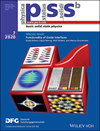Description physica status solidi was established in 1961. In 1970 it was divided into two series: physica status solidi (b) - basic research and physica status solidi (a) - applied research. The aim of physica status solidi is the rapid publication of important and new results in the field of solid state physics both in fundamental and applied research. The journal publishes Review Articles Original Papers and Rapid Research Notes each volume contains an author index. Each issue of the two series provides 8 thematic categories: structure and lattice properties; surfaces interfaces thin films; nonelectronic transport; electronic states low-dimensional systems; electronic transport superconductivity; magnetic properties magnetic resonances; dielectric and optical properties; device-related phenomena. Series (b) is devoted to basic research and covers such significant topics as electronic states and transitions lattice dynamics disordered lower-dimensional and organic systems surfaces high-excitation phenomena etc. Kurztext physica status solidi wurde 1961 in einer Serie gegründet. 1970 wurde eine Teilung der Zeitschrift in Grundlagenforschung (physica status solidi (b) - basic research) und angewandte Forschung (physica status solidi (a) - applied research) vorgenommen. Jeder Band beider Serien enthält Arbeiten zu den thematischen Gebieten: Struktur; Defekte nichtelektronischer Transport; Gittereigenschaften; Oberflächen Grenzflächen dünne Schichten niedrig-dimensionale Systeme; ausgedehnte sowie lokalisierte elektronische Zustände und Übergänge; elektronischer Transport und Supraleitung; magnetische Eigenschaften und Resonanzen; dielektrische und optische Eigenschaften; bauelementebezogene Phänomene. Readers Physicists chemists crystallographers materials scientists dealing with solid-state physics in basic research and teaching
